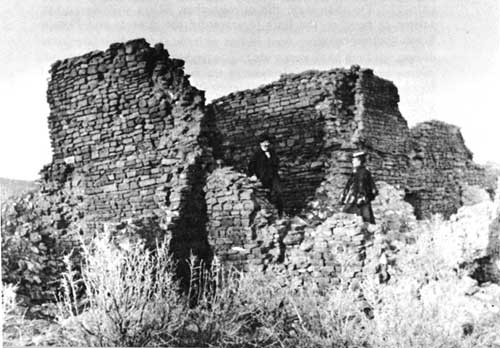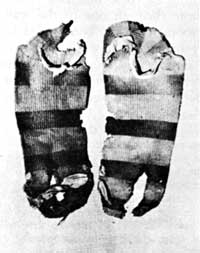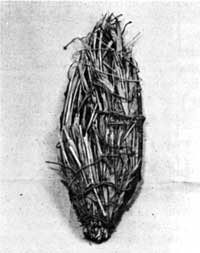|
AZTEC RUINS National Monument |
 |

Aztec Ruins in 1895.
Explorations and Excavations (continued)
By 1880 the settlers in the valley, concerned about the education of their children, had established a small, 1-room school. Sherman S. Howe, long a resident of the Animas area, was one of the first boys to attend this school, and in 1947, a few years before his death, he recorded for posterity his remembrances of the valley and the first real exploration of the Aztec ruins. A schoolteacher named Johnson, who hailed from Michigan and who must have been quite a remarkable man for his day, was greatly intrigued by the ruins. Sometime during the winter of 1881-82, he encouraged the school children to go out with him for a day on a trip to explore the ruins. Howe remembers the event well, for although he was among the younger boys, he was also among the first to volunteer to go. The following Saturday, about seven or eight of the boys arrived at the Aztec ruins with picks, shovels, and a crowbar, to meet with the teacher. As Howe used to tell it:
It was snowing a little and quite cold. We went into a second-story room, more than half full of dirt, and began digging down at the corner of the room. We struck the second floor at about five feet, and broke a hole through about two and one-half feet in diameter, but could see nothing but a black dungeon below. There was a prolonged debate about the depth of it, what might be at the bottom, and how a person could ever get back if he did go down there. Some thought it might be full of rats, skunks, bats, or rattlesnakes. We could imagine a hundred things. I believe the dread of ghosts was the worst.
Howe evidently wanted to be the first one down but the teacher felt it would be better if one of the older boys went first; so one was selected and lowered on a rope. Naturally at the last moment the boy was a little hesitant about being lowered into a dark hole which, after being sealed airtight for centuries, had a "musty odor which was not at all pleasant." Finally, however, having been teased by his friends, he dropped down into the room. Soon the rest of the boys were also getting down the best way they could. As Howe described it:
We were in a room—a clean room, with ceiling and walls, open doorways, all just as they had been left. We were walking on floors which had not been trodden by human feet for centuries. There was an open door leading into the next room to the northwest. It was also clean and in perfect condition. There was no trash on the floor, no ashes, not even a scrap of pottery.
Mr. Johnson seemed disappointed and puzzled. "Who were these people who built these large buildings and such splendid rooms? Did they not leave something behind that would give us some information? Could they not write, to give us some description of themselves or a bit of history?" Such thoughts and questions as these were racing through the mind of our teacher. He was thinking aloud, and making us do some thinking also. I felt very nervous and uncomfortable down in that dark, dismal place.
Disappointed at not finding anything in these first two rooms, the teacher and his boys broke a hole through one of the walls into a third room next door. This room, too, had been sealed for many centuries, and the candles they had brought would not burn properly until enough fresh air had circulated through the hole in the wall. But this room held a surprise for the boys. Bit by bit, as their candles burned better the room became brighter, and then:
When we could see across the room, there was a human skeleton facing us with its back to the wall. It had been placed there with no wrappings around it whatever. It was not mummified, but the ligaments had dried, holding the bones in place except that the head had tilted back and was resting against the wall. There was some dried skin and hair lying around it. The body had been flexed in the usual manner, but instead of wrapping and tying in the matting, as the custom was, it seemed to have been just placed there nude. We all stood motionless, nobody saying a word. It must be that we were struck dumb with awe, and that we were debating in our minds whether to stand our ground or retreat.
The photo in the original handbook
pictured human remains. Out of respect to the Pueblo descendants of the
people who lived at Aztec Ruins, the depiction of human remains and
funerary objects will not be displayed in the online edition.
Mummies of Aztec Ruins.
This was as much as the boys and the teacher could do in the short time they had the first day out at the ruins, but they all agreed that they would meet again the following Saturday and continue their explorations. However, during the week the boys had told their parents about what they were doing, and the next Saturday when Howe showed up there was a crowd of older men present who quickly began to break into a number of other rooms. Howe remembers entering one room with them:
We entered the room through the hole in the floor and passed through the open doorway into the northwest room. We broke a hole through the wall and entered the room to the northeast, and there we really did see things! I got into that room and stood, trying my best to take it all in and see everything I could, while that excited crowd were rummaging it, scattering and turning everything into a mess. There were thirteen skeletons ranging from infants to adults. The infants were two in number. The skulls had not knit together. One of them had two teeth. All were wrapped in matting similar to that around tea chests that come from China, and tied with strings made from fiber of the yucca plant. There were large pieces of cotton cloth. Most of it was plain, resembling our ten-ounce duck. It was in good state of preservation except that it was somewhat colored with age. Some of the cloth had a colored (red) design in stripes. There was also some feather cloth, and several pieces of matting of various types. There were several baskets, some of the best that I have ever seen, all well preserved. There were a lot of sandals, some very good, others showing considerable wear. There was a large quantity of pottery, all Mesa Verde. Some of the pottery was very pretty and new looking.
There were a great many beads and ornaments. I cannot give a description of these, as I had no opportunity to examine them closely. I remember seeing quite a lot of turquoise. There were a number of stone axes, polished, and much nicer in appearance than the average type found in this vicinity. There were also skinning knives, so-called, and sandal lasts; cushions or rings they wore on their heads for carrying burdens—some made of yucca, nicely woven or braided; some made very plain, in coils of yucca strips, tied in various places to hold the strips together; some were made of juniper bark wrapped with strings, and some were made of corn husks. These may have been used also as jar rests to support vessels with convex bottoms which would not stand upright very well without some kind of support.
 Woven yucca sandals. |
 Probable snowshoe made of willow, reeds, and yucca fibers. Length 20". |
Obviously, findings such as these could not long remain a secret, and for a considerable time it was a favorite weekend sport to hunt for old remains at this ruin and others in the immediate vicinity. A great quantity of invaluable archeological material must have been carried away in this manner and has long since been lost or scattered among private individuals. A little of it got into museum collections, but most of it was carried off by the people who found it and who then left it in obscure corners of their houses until it was broken or lost. As Howe himself said in his later days when he remembered these early findings:
When we had finished this work, the stuff was taken out and carried off by different members of the party, but where is it now? Nobody knows. Like most of the material from the smaller pueblos around the larger buildings, it is gone. I, being only a small kid, did not get my choice of artifacts, I had to take what was left, which made a nice little collection, at that. But it, too, is about all gone.
We went on with our work, opening all of the rooms that visitors now pass through with the guides, but we found nothing more. The holes that we made through the walls have been converted into doorways through which all visitors now pass from room to room.
For a number of years, rather indiscriminate looting by pothunters and others interested in these antiquities continued sporadically. Luckily, the pothunters did not get into the rooms which seemed to require a lot of hard work and digging, but merely broke into those rooms which were still more or less intact and in which readily accessible material was lying around on the floor or scattered through the debris.
In 1889, a patent covering the site of the Aztec ruins was issued to John R. Kuntz and continued in his possession until 1907, when it was transferred to H. D. Abrams. Due largely to the efforts of these gentlemen, the ruins were relatively protected against vandalism until it could be scientifically investigated by Morris in 1916.

|

|
|
Last Modified: Tues, Feb 20 2001 10:00:00 pm PDT |


